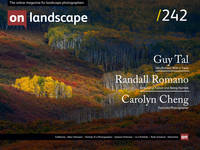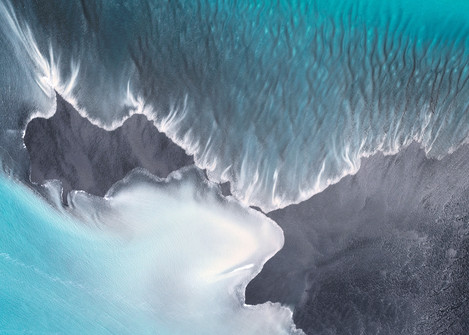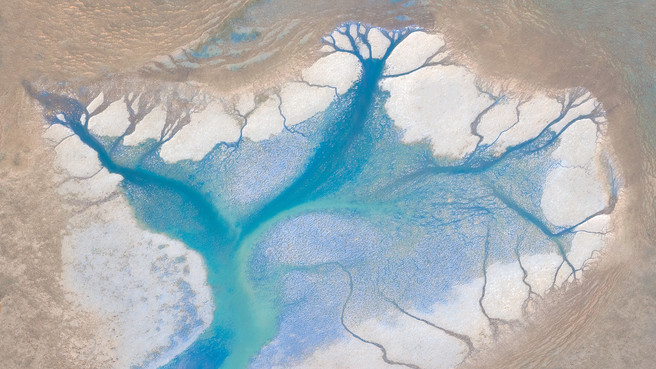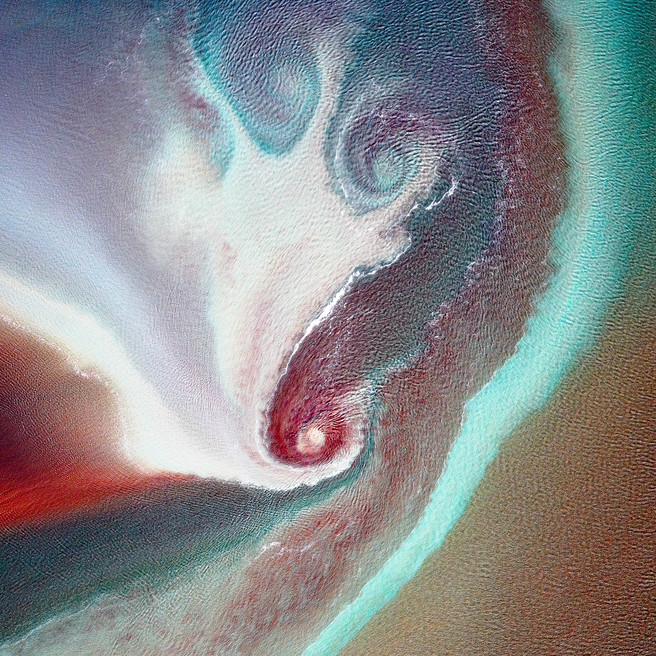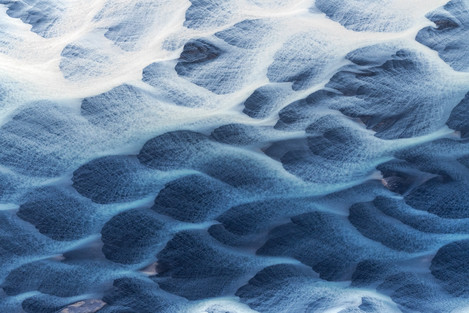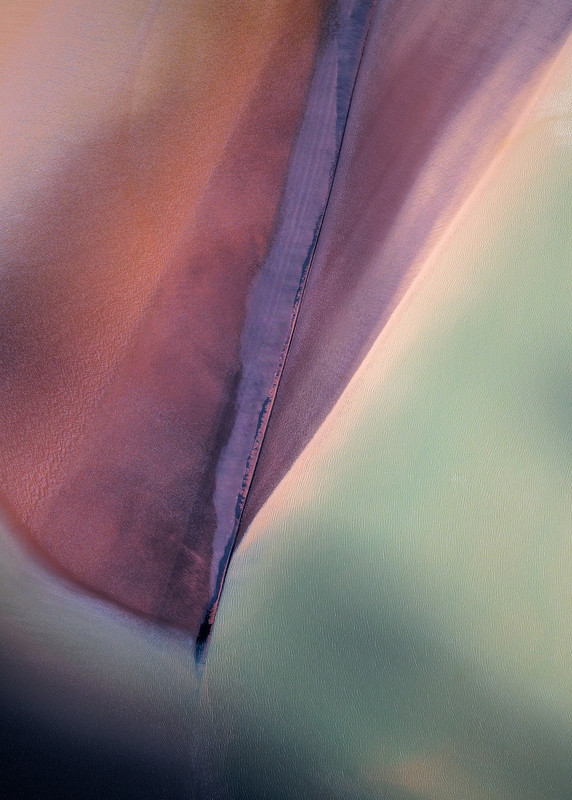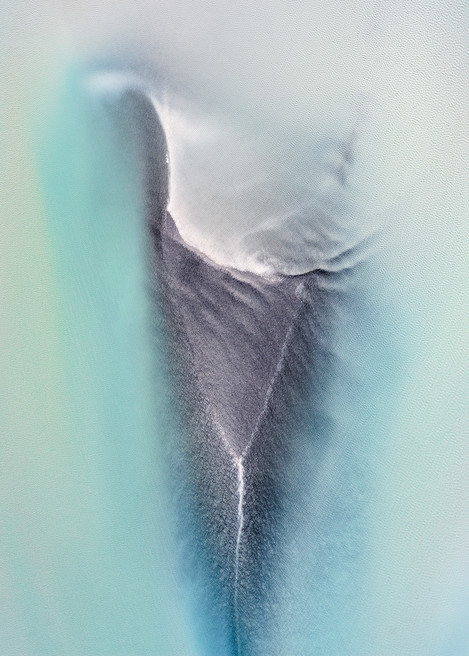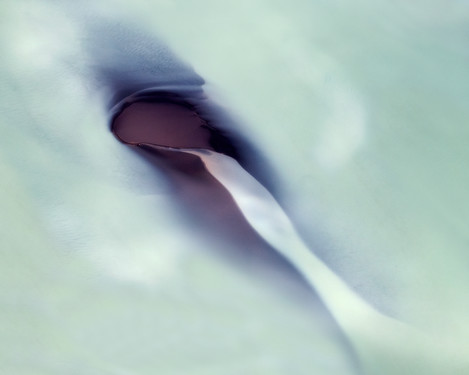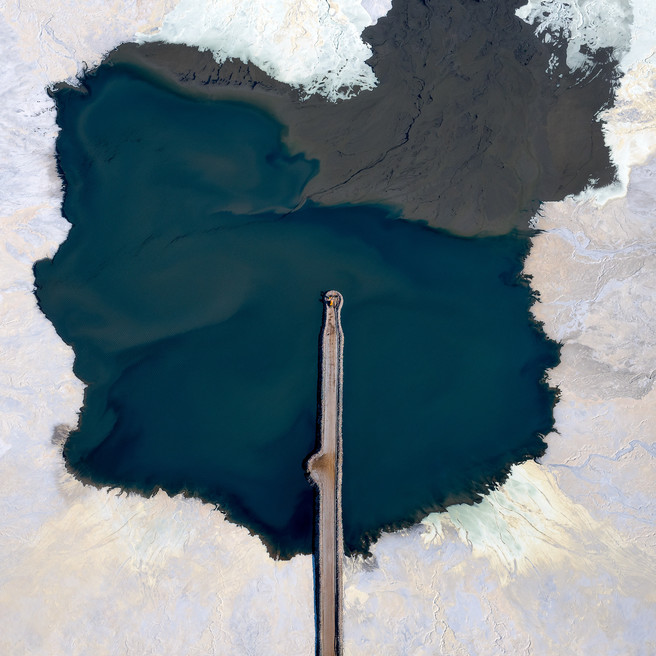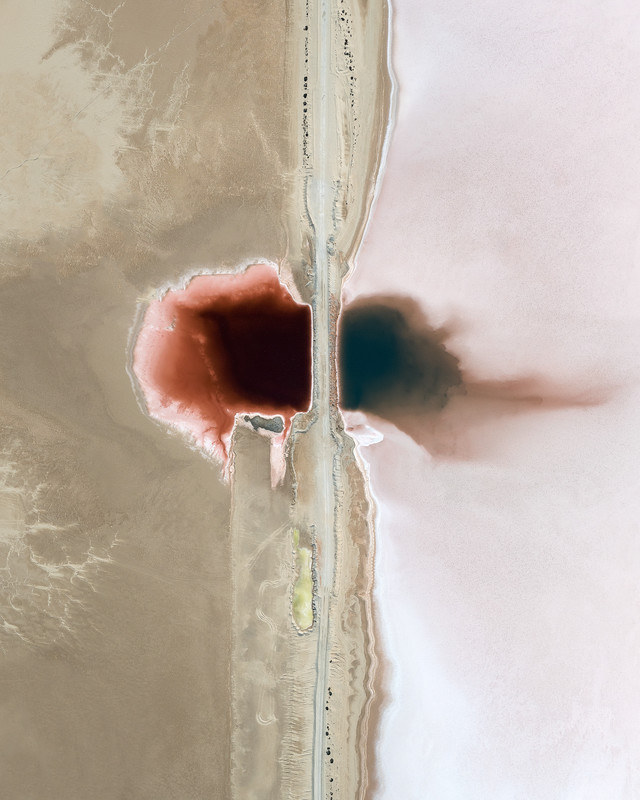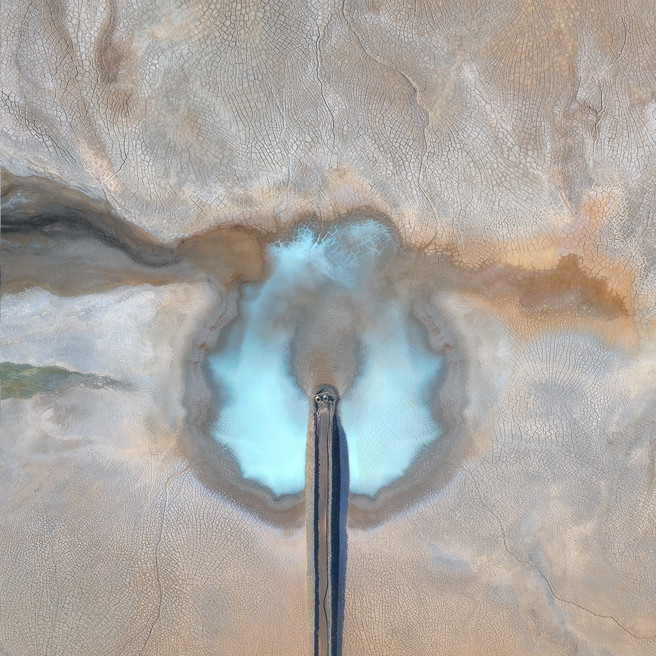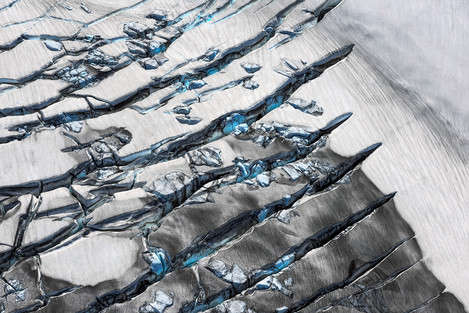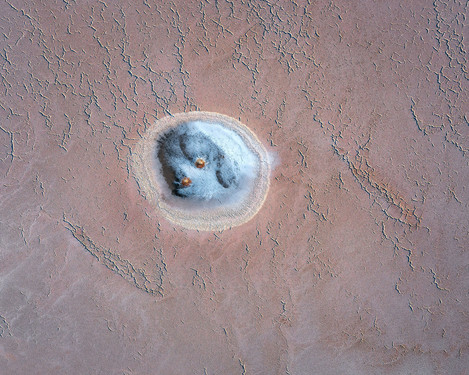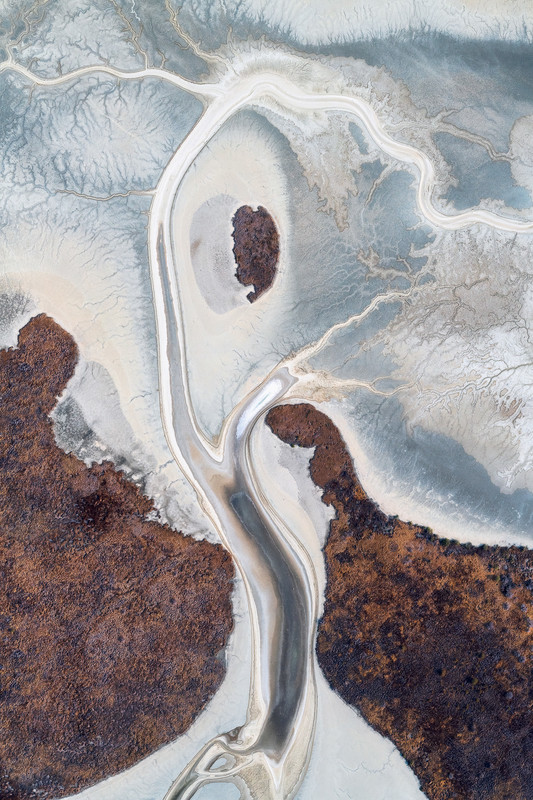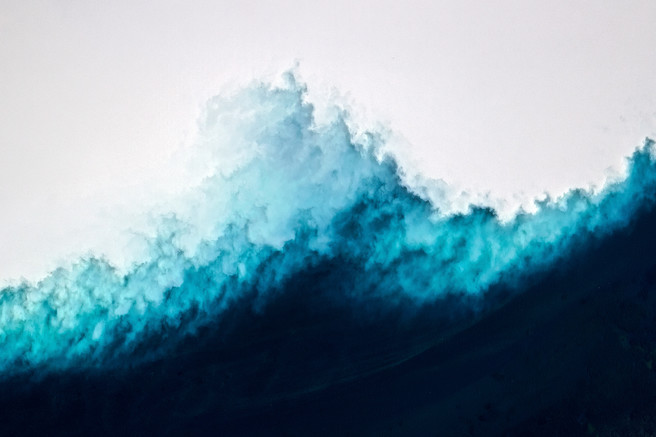Featured Photographer

Carolyn Cheng
Carolyn Cheng is an abstract and aerial photographer who examines the feminine sublime in the natural world. She is based in Toronto, Canada.

Michéla Griffith
In 2012 I paused by my local river and everything changed. I’ve moved away from what many expect photographs to be: my images deconstruct the literal and reimagine the subjective, reflecting the curiosity that water has inspired in my practice. Water has been my conduit: it has sharpened my vision, given me permission to experiment and continues to introduce me to new ways of seeing.
Tim’s talked before about having a love/hate relationship with aerial photos – a bit like Marmite for those of you who know what that is (other yeast extracts are probably available). But really as with most landscape photography, once you get over the shock of the new and the novel it comes down to how well it’s done and whether the post-processing enhances the image or detracts from it. Subtle post-processing was one factor in our choice of Featured Photographer for this issue. I forget now if I first noticed Carolyn’s work on the back of a competition or in a ‘top photographers of’ list; the fact is that the work stayed with me. Competitions and lists aren’t guaranteed to be the best place to find subtle work but it does exist and is well worth seeking out. At the time of writing, I’m certainly looking forward to seeing what comes out of the inaugural Natural Landscape Photography Awards.
For me, successful aerial photography needs to show something more than just an elevated viewpoint (though who hasn’t at times wished their tripod would elevate a little?). It helps too if there’s a story to it or from it, and this again is one of Carolyn’s strengths.
Would you like to start by telling readers a little about yourself – where you grew up, your education and early interests, and what that led you to do?
Like many Canadians, part of my identity has been forged by how my family arrived in the country. My father, who was born in China, first found an opportunity in the United States as a graduate student in the 1960s and, fatefully, decided to visit Canada for the first time for Expo ‘67. Here, he fell in love with the country’s hospitality and landed a position as one of the first professors of mechanical engineering at the University of Ottawa.
I grew up in Ottawa, although we were fortunate to be given many opportunities to travel. We would journey to visit family, as far away as Taiwan, but also in Canada, the United States and Europe. My father also took us on a six month sabbatical to Paris when I was in grade school, which allowed me to experience a very different culture and learn to adapt quickly! Consequently, I always felt both rooted in my hometown of Ottawa, but also part of a larger cultural fabric that spanned different geographies.
My own undergraduate studies were in business. I started out my early employment in management consulting and developed my skills in strategy and operations. Later, I furthered my studies and, like my father, I decided to do my graduate studies abroad at the London School of Economics and Political Science with a Masters in International Relations. I am currently the Chief Operating Officer at Royal LePage, which is a national residential real estate franchisor in Canada.
As you may imagine, my love of travel and photography was instilled in me at an early age, through my family’s travels. Whether through visiting family, or travelling with my father for his annual conferences, we were fortunate enough to experience many places, from big cities to grand natural landscapes. It will serve as no surprise that my early photographic forays were more travel and documentary-oriented.
Although you’ve had an interest in photography for a while, did anything in particular prompt you to start taking it more seriously? How much time are you able to find for it?
In my thirties, I was an avid road racer. I loved the physicality of the sport and training was a great way to stay fit for outdoor pursuits and relieve the stress of the workday. Racing sometimes comes at a price though, and after a number of crashes and with general wear and tear, one day, for no particular reason and rather unspectacularly, I could no longer sit comfortably on my bike. To this day, I still have some lingering physical issues which limit me to lower intensity activity. So, while the racing door closed, the photography one opened.
As I pondered what to do with my newly free time, I realised that travel and photography were my greatest passions so, now, with more purpose, I sought to develop the capability to do it more skillfully and artistically. Typically, I spend part of my weekend and almost all of my vacation dedicated to photography.
Who (photographers, artists or individuals) or what has most inspired you, or driven you forward in your own development as a photographer?
When I first began thinking about photography, it was the images of Marsel van Oosten, Sarah Marino and Antony Spencer that really inspired me.
As I began my own journey, I quickly realised that I gravitated to more intimate styles of photography. Part of this discovery came by chance. On an aerial photography trip to Australia, I was having issues with my 50mm lens so I was, in hindsight, luckily forced to use my 85mm one only. Through the abstraction necessary when photographing with that lens in the air, I began to use the landscape almost as a medium, rather than a subject, more so portraying the painterly shapes, lyrical patterns and vibrant colours of nature that are almost unimaginable from the ground. My next aerial trip was to Iceland, where I would fly solo with a pilot for the first time. It was on this trip, where I had complete creative freedom, that I fully embraced my passion for the intimate landscape and further developed my voice as a photographer.
Throughout my journey, I must also credit David Thompson for helping me to accelerate my development. He’s taught me a lot about the importance of composition and processing to realise your artistic vision. As a mentor, he is someone who always provides both the constructive criticism and positive support necessary for a photographer to develop in their own style. I am incredibly grateful to have met him early in my journey.
Finally, the perusal of hundreds of images on a daily basis to discern what I respond to and what I don’t respond to, as well as the critical review of my own images, have both been essential elements of my education as a photographer. In the field, I am responding to what’s in front of me and applying my vision, but how that vision has been developed is also subconsciously influenced by the many images I have previously seen.
What led you to first go up in the air? Was your first experience of planes or drones, and which do you prefer?
In my first couple of landscape photography workshops, as a small part of the overall trip, I was lucky enough to get up in the air. I was drawn to both the exhilaration of the experience as well as seeing from a new perspective. In my daily life and work, my mind likes to discern patterns from complex sets of information and I also see images in this manner. Being up in the air, where landforms can be abstracted into shapes and patterns, I can more easily apply this skill.
Interestingly, part of this pattern recognition works on both a conscious and subconscious level. In the air, while I still actively compose, I don’t always have as much time to do so, hence I work more quickly, using intuition that draws from my life experiences and references. I think there is a magic to what your mind can do subconsciously and I’m always curious, on review, to see what I have responded to.
More recently, I have also had the chance to work with drones. While it is also a type of aerial photography, much of the visceral experience from an aircraft is not actually present when flying a drone, as your visual experience is intermediated with an iPhone or tablet. Also, given that much of your time and attention is focused on piloting the drone, often with very deliberate movements, the instinctive elements of aerial photography are absent from this experience. While I would typically prefer to fly in an aircraft for the experiential part of aerial photography, I do appreciate that drones give photographers another perspective. A perspective a couple of hundred feet off the ground almost from any angle is quite different to a higher top-down perspective at 1,500 feet from an aeroplane. It’s great to have different tools to realise a different vision.
Can you give readers an insight into your workflow – the cameras and lenses you most enjoy using, and how you approach processing and editing?
When I am up in the air, I typically have two cameras. My primary setup is a Nikon D850 with a Sigma Art 85mm f1.4. Typically, in the air, 80%+ of my photographs will be taken with this lens. My secondary setup is a Nikon D810 with the Nikon 24-70mm f2.8, which I use when I would like to capture a wider scene, although I have just recently converted that backup setup to a mirrorless camera with the Nikon Z7II.
When I’m in the field, I typically download my images after the day’s photography and have a quick look to ensure the images are sharp, mark my favourites and, if I’ve had trouble photographing well that day, assess what I might change about how I compose the next day.
Once home, as I start to process the work which may be up to 3 - 6 months later, I re-review the full set of images for my favourites, export them as a group, and determine which images might flow nicely together and prioritise the images I will process on that basis.
My workflow can vary from image to image. For some images, I have an immediate sense of how the image should be processed. Others require more experimentation and I will try different techniques and iterations before settling on how to bring that image to life. Once I figure out the way forward, I get the canvas in order. With aerials, for instance, I may transform an image slightly to get it to a bird’s-eye view if it was shot with a slight angle. Afterwards, there are the more typical contrast adjustments, followed by the removal of any colour casts and finishing with any burning or dodging to give the image additional flow or a greater 3-dimensional effect to help move the viewer’s eye through the image.
What reaction do you hope to provoke in viewers? Some of your series titles hint at the tension between wonder and awe (in the sense of fear) and I was interested to hear that it took a gallery submission’s theme to find the language needed for you to feel comfortable in showing your images in the series Sublime Waste?
As I have progressed in my journey as a photographer, I find the images that have the most impact on me are those that provoke an emotional reaction, and perhaps, at their very best, a conversation. I hope my work helps elicit these same responses in viewers.
With abstract photography, as many of the places photographed may not be recognisable, something about the image, whether it’s its shape, colour or intensity, must resonate with the viewer in order to create a connection. They may have a personal connection to the image that is similar to mine or completely different. And, while the viewer’s personal interpretation is critical, I also think framing the image through the use of the title or through accompanying writing can help the viewer navigate their perspective of the image. At times, I like to provide geological information and in other cases, I will mention the visual reference to a well-known symbol or metaphor that has personal meaning to me. Together, I always hope that the image and the writing can provide the context to elicit an emotional response or a conversation.
With Sublime Waste specifically, I had been reluctant to photograph altered lands as I wanted to ensure, given my aesthetic, that I was not glorifying mining operations. In addition, I had a desire to have in-depth information to contextualise the various environmental issues in a balanced manner. I knew it would be difficult to do this without access to insiders in the mining industry and amongst environmental activists.
As luck would have it, on the day I took the images for Sublime Waste, we were in an area with difficult lighting conditions to photograph a very delicate natural area. Our only alternative was the altered landscape. I had to adapt and give it a try. I sat on these images for a long time until I could wrestle through my concerns. My breakthrough came when I saw an exhibit submission called Seeking the Periphery. The exhibit was looking for images that aren’t typically seen, but rather exist at the margins of our society. This theme highlighted that through city living, we are often removed and disassociated from the means of production, and thus, we can unintentionally ignore the environmental consequences of feeding our consumption. By highlighting this aspect of the human condition, it could invite conversations to generate awareness about our environmental footprint as opposed to requiring answers to the perfect balance between mining, the economy and the environment.
In terms of generating an emotional response and a conversation, I received this comment from a university friend who was a gold mining engineer:
“Carolyn, amazing photo of the tailings dam. It works for me on multiple levels, and probably on some that you didn’t necessarily intend but resonate with me due to my time building tailings dams in the gold mining industry. Never has a photo captured my internal conflict of love of nature against my need/compulsion to build infrastructure.”
My friend later wrote to me that after a failed project, he left his job and began working in more mission-based work, only in renewable energy sources. This image helped him process the emotions he had gone through and this was so incredibly touching to me.
Would you like to choose 2-3 favourite photographs from your own portfolio and tell us a little about why they are special to you?
In many ways, my favourite photographs were somewhat unexpected images that were directly connected to breakthroughs in my creative process.
Ode to Georgia O’Keeffe
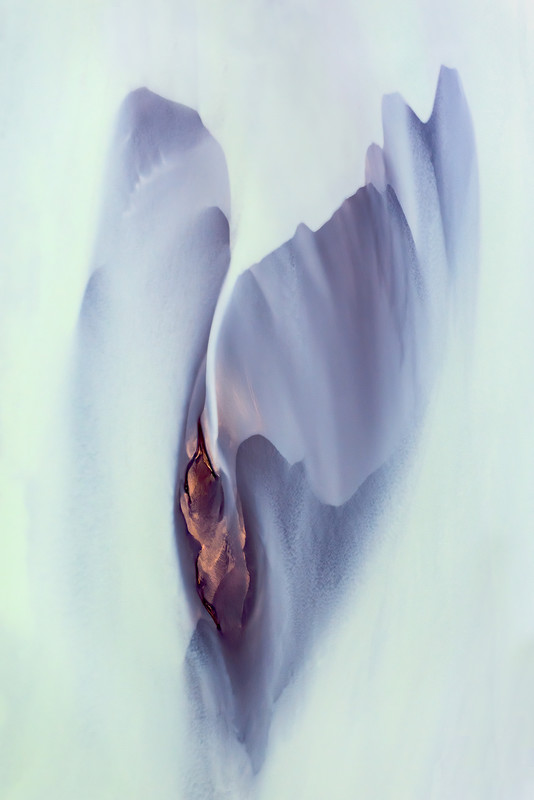
This photo was taken in one of my favourite areas to photograph in Iceland. I really enjoy how the glacial meltwater picks up sediment through its traverse across the country to give the river a luminescent mint green colour. This image is special to me because it transcends the subject matter by evoking, for me, the soft and delicate elements of an abstracted flower or an enveloped figure, providing a sense of care and protection.
Sublime Waste I, Gold Mirage
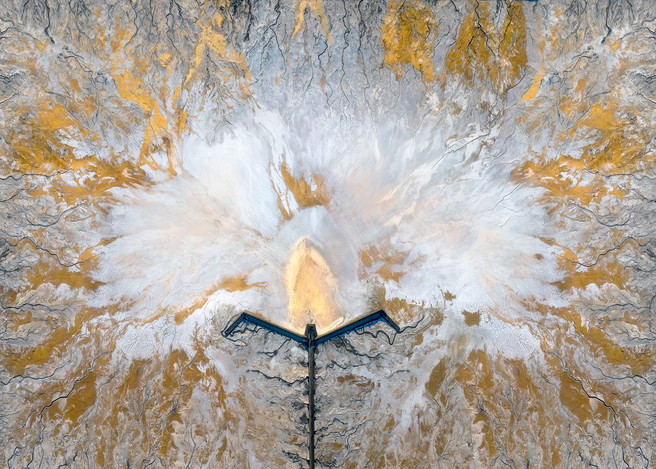
I have a strong positive association with Gold Mirage as it is the showcase image for my first series of altered landscapes. Despite my aforementioned reluctance to photograph altered landscapes, as we flew over the tailing ponds close to sunset, the light caught the water of this tailing pond and for a brief moment, painted the brown waters a shimmering gold. Given that we were photographing tailing ponds from gold mines, I knew this image would play an important role in sharing the story of the area.
Intimacy
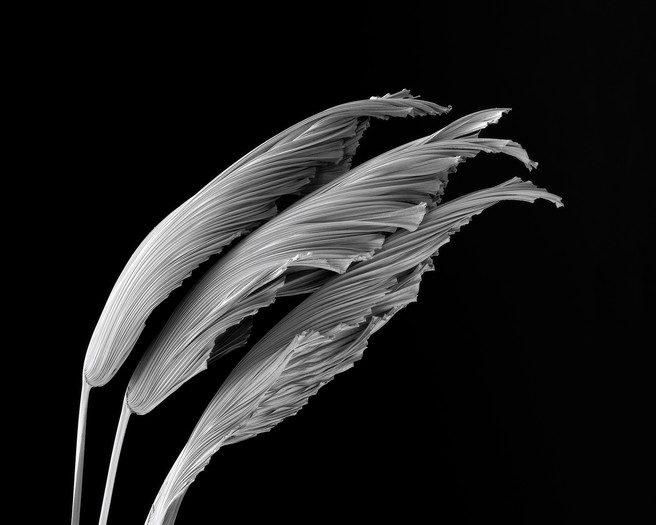
During the pandemic, I have been exploring new avenues of photography locally. In that process, I have developed a genuine enthusiasm for photographing at local botanical gardens and processing for the first time in black and white, possibly as part of my desire to portray a world out of the ordinary. A fellow artist told me that some of my compositions made her think of Robert Mapplethorpe. Intrigued, as I did my research, I focused on his floral still life work and marvelled at the originality and power of his compositions. For my first studio session, I had been struggling with arranging these tough dried leaves but perhaps inspired by Mapplethorpe’s imagery, eventually I was able to produce my favourite studio image made to date. Likely, in these times of social distancing and isolation, the togetherness of these leaves strikes an emotional chord.
Looking at some of the images from Weathering Sands that you exhibited for the Toronto Outdoor Art Fair, I was struck by their textural qualities (Rising, Cyclone) and I wanted to ask if you ordinarily choose to print and present your images to emphasis this?
That’s a great observation!
The textures you see in the series Weathering Sands were very specific to that region of Australia. Either the winds and/or currents were quite strong that day. When I process my images, I respond to what the scene offers. In this case, the texture was a key part of the image. As this was the first time I had so much water texture in the images, the printing process did yield interesting and unexpected results.
I softened the textures in Cyclone but maintained its feeling of turbulence which ended up translating well to print. Rising, on the other hand, when printed actually gave me an uneasy bodily sensation as well as goosebumps. It’s an image that I enjoy from a distance in print, but not close-up. Given this, it’s one that I will showcase in digital form only. Interestingly, it's the only print I’ve ever felt that way about. As much as I enjoy digital work, I typically prefer prints even more. It really is another version of the work. It was a good lesson to learn.
Do you increasingly find inspiration and draw motivation from areas other than photography?
Throughout my life, I have been drawn to post-impressionist and abstract expressionist painters. For instance, Mark Rothko’s minimalist paintings have always evoked a powerful emotional response in me. I also find Georgia O’Keeffe’s intense abstract floral paintings deeply resonate and I am very drawn to Giorgio Mirandi’s later abstract bottle still lifes.
Recently, I have been fascinated by conceptual artists whose work leaves an indelible impression because of its ambition, scale and monumentality. More essentially, it is work that really makes you think and question what we currently understand.
Two of these artists are James Turrell and Ai Wei Wei. James Turrell fascinates me because, instead of using light to create his art like most painters and photographers do, his medium is actually light itself. With light, since there is no object or image to speak of, his art is about how we see and experience light or, effectively, our perception.
Ai Wei Wei first captured my interest from an exhibit at the Art Gallery of Ontario in 2013. As a political activist and a conceptual artist, he focuses on social critique. In the wake of a massive earthquake in China in 2008 that ultimately killed 90,000 people, he sought to bring attention to, and commemorate, the 5,000 school children who died when the poorly constructed schools collapsed. Straight is the piece that had the most visceral emotional impact for me. Ai Wei Wei recovered the specific rebar from the fallen school buildings and took painstaking efforts to straighten 150 of them. They were laid in multiple rows in a huge rectangular, multi-layered and curving shape. The rusted steel rods depicted the failed practices, the curves denoted the seismic waves of the earthquake itself which ultimately led to the death of the children, for which each steel rod looked like a child laid to rest. The work was confronting and horrifying. It was astonishing how those lifeless steel rods could evoke such a powerful reaction.
We’ve talked about the sublime in On Landscape before. How does the Feminine Sublime differ, or what would you like readers to understand from the term?
The traditional definition of the Sublime started with Edmund Burke in the 18th century and evolved throughout history in European and American schools. In essence, it proposes that nature inspires awe and terror, it occupies a vastness of dramatic scale and, taken together, evokes divinity, the unrepresentable and/or transcendence. In some representations, it alludes to humanity’s need to dominate or conquer their terror. While I do believe that some of these elements are contained within my work, my work doesn’t fully align with this concept.
The Feminine Sublime, on the other hand, focuses more exclusively on the dimension of the unrepresentable or the otherworldly. It doesn’t seek to master, appropriate or dominate the other; rather it takes up a position of respect to nature. When combined with the notion of ecofeminism, it’s a departure from the view of nature in a mechanised world, where its only use is for consumption, but rather to have a coexistence between humanity and nature where we must develop a sustainable relationship.
My imagery, when you essentialise it, shows symbiotic parts of nature where we see the interplay of water, sand, salt and sediment in a very dynamic form, where patterns are formed, dispersed and then regenerated. It illustrates the basic cycles of the landscape in its natural state. As the images are taken from an aerial perspective though, viewers can’t always immediately comprehend or contextualise the work so it can feel otherworldly. It’s always such a surprise and delight to me when viewers realise that what’s photographed is simply water, sand, salt or earth. In that sense, my work is about transforming ordinary elements into beautiful, moving images that give us a sense or a possibility of the otherworldly. It shifts our sense of perception, in a way, of what’s possible.
You’ve said that your discussions and research have helped you to contextualise and present your images. Do you feel that with time they will influence the direction that you head in or the work that you want to make?
The pandemic, world events, and my research will all certainly influence the direction of my work. The pandemic has required that we photograph more locally, but it has also clearly highlighted that local decisions impact the rest of the world. When I started photography, I was influenced by my love of travel and my desire to visit places different from my home country, but I have been growing as a photographer and certainly, after recent experiences, I would like to explore some of the local issues where I live that have a global impact. For instance, closer to home, I would be interested in photographing the impact of the Canadian tar sands on the environment.
While we’ve had restrictions on travel, have you managed to find a creative release in or close to home or had an opportunity to develop any new skills?
Yes! At one time, I believe that Toronto was one of the most locked down cities in the world, so, in this second year of the pandemic, after I finished processing my photo archives, I began exploring my local botanical gardens with a macro lens and photographing still lifes in the studio.
I have not yet published these photos, but the reaction from my inner circle has been very positive, drawing the connection from my aerial work to these new images. As I branch into new avenues of exploration, I aspire to Mapplethorpe’s approach to photography: “My whole point is to transcend the subject… Go beyond the subject somehow, so that the composition, the lighting, all around, reaches a certain point of perfection. That’s what I’m doing. Whether it’s a cock” (aerial photography for me!) “or a flower, I’m looking at it in the same way… in my own way, with my own eyes.”
While these new pursuits are very different from aerial photography, I have enjoyed how photographing locally has allowed me to see an ecosystem over a period of time and to photograph a plant’s most expressive moment, whereas, for budgetary reasons, my time with an aerial landscape is far more fleeting. And, photographing in the studio has really challenged me creatively as I cannot rely on nature to be my artist. Rather, I must find a subject, craft the composition and light the scene in a manner that resonates. It’s an entirely different kind of creativity!
If you had to take a break from all things photographic for a week, what would you end up doing? What other hobbies or interests do you have?
One thing that I’ve missed quite a bit since I began to focus on photography is regular travel. As a traveller, I enjoy immersing myself in local culture, especially if I have ample time to explore and enjoy the journey. I did my share of backpacking when I was younger, which was a fun and adventurous way of travelling, with less structure and more spontaneous experiences. Here, the emphasis is much more on the journey rather than the image.
Separate from travel, I like to enjoy the arts and culture in the city, including museum-going, watching films, sampling restaurants, as well as taking day trips for hiking or cycling.
And finally, is there someone whose photography you enjoy - perhaps someone that we may not have come across - and whose work you think we should feature in a future issue? They can be amateur or professional.
Recently, I have really been enjoying Krista McCuish’s photography. Her intimate images of her local landscape as well as her still life images from her cabinet of curiosities have been inspiring. I encourage viewers to look up her work!
Thank you, Carolyn. It’s fascinating to have a glimpse of your new work, and I can certainly see the parallels with the forms and shapes of your aerial abstracts. It will be interesting to see where these go, and perhaps to see the two displayed side by side.
You can enjoy more of the Feminine Sublime on Carolyn’s website. While we were concluding the interview earlier this year I spotted both Sublime Waste and Weathering Sands had done rather well in the 2021 Px3 Awards. You can also connect with Carolyn on Instagram and Facebook.
Krista McCuish’s work continues to develop and her recent studio work has indeed been somewhat sublime. You can read our interview with her here.
- Turbulence
- Sublime Waste Viii
- Sublime Waste IV
- Sublime Waste Ii
- Spirit Of Kakadu
- Slash
- Rising
- Repose
- Releve
- Parched
- Heartbeat
- Go West
- Cyclone
- Confluence
- Charged
- Sublime Waste I, Gold Mirage
- Ode To Georgia O Keeffe
- Intimacy

